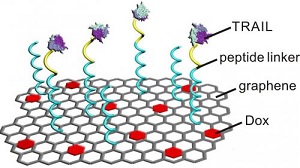 |
| Graphene strip with doxorubicin (red) and TRAIL (purple)--Courtesy of Zhen Gu |
Treating cancer often requires a multiple-pronged approach with different drugs acting together to attack different parts of a tumor or perform different functions to stop cells from dividing uncontrollably. With drug delivery platforms that can carry two drugs separately, this can be accomplished in a single treatment.
Researchers at North Carolina State University, the University of North Carolina and China Pharmaceutical University have developed graphene strips that have demonstrated the ability to carry two different cancer drugs and target each to the part of the cell where it will be most effective, according to NCSU. The surface area of a flat strip in particular suits these particles to the delivery of the cancer drugs TRAIL and doxorubicin. The work has been published online in Advanced Materials.
TRAIL is most effective on the surface of the cell, whereas doxorubicin does its work on the cell's nucleus. The doxorubicin is tied in to the graphene's structure, while TRAIL latches onto the surface of the graphene via peptide connections. With TRAIL on the surface of the graphene strip, receptors on the cancer cell zero in on the molecule, attaching the whole nanoparticle to the cell's surface at first, where the TRAIL will remain to perform its function. The graphene with the doxorubicin, on the other hand, is absorbed by the cell, allowing the drug to initialize cell death from the nucleus within, while TRAIL works from the outside--a battle on two fronts.
The team used human lung cancer tumors implanted in mice to test the technique--which they call a "flying carpet"--and it showed to be more effective than doxorubicin or TRAIL alone or even a combination of the two with graphene that didn't allow for the separation of TRAIL at the cell's surface.
Lead author Zhen Gu and his team specialize in delivering multiple cancer drugs at a time in a single particle, having developed platforms such as nano-cocoons and nano-daisies in the past. What stands apart with the graphene strips is the surface area of the particle, which allows for more effective and efficient delivery.
"These drug-rich graphene strips are introduced into the bloodstream in solution, and then travel through the bloodstream like nanoscale flying carpets," Gu said in a statement. "We've demonstrated that TRAIL itself can be used to attach a drug delivery system to a cancer cell, without using intervening material--which is something we didn't know. … And because graphene has a large surface area, this technique enhances our ability to apply TRAIL to its target on cancer cell membranes."
- here's the release
- get the research abstract